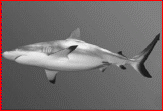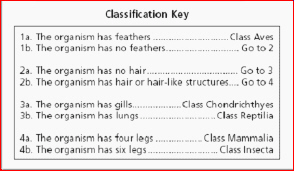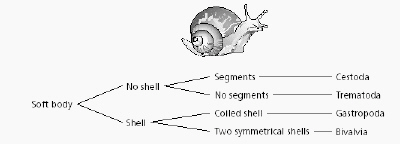Online Study Guide
Instructions
1) You
do not need to type in your name in the space in the top-left area above. The results of this study
guide will not be sent to your teacher.
2) Carefully read each question and all the answer
choices.
3) Select the correct letter from the drop-down feature to the left of each
question.
4) When you are finished, click the “Check Your Work” button in the
bottom-left corner of the page.
5) The software will grade your work, and then it will show
you the results. Note that the correct answer will be displayed beneath the questions.
6)
Keep doing the study guide over until you earn a 100 on it.
|
|
|
1.
|
An organism like the one shown in the
picture below is caught in a net.


Using the classification key above,
identify the organism’s class.a. | Class Insecta | b. | Class
Chondrichthyes | c. | Class
Mammalia |
|
|
|
2.
|
A fish and a dichotomous key are shown
below
According to the
dichotomous key, which fish is pictured? a. | smallmouth
bass | b. | lantern
fish | c. | yellow
perch |
|
|
|
3.
|
Dichotomous Key of
Chlorophyll-Containing Organisms.
| #1 | a. This organism is not a plant. | (algae) | | | b. This organism is a
plant. | (go to step 2) | | | | #2 | a. This plant does not have vascular tissue. | (go to step 3) | | | b. This plant has vascular
tissue. | (go to step 4) | | | | #3 | a.
The spore-producing capsule opens by splitting lengthwise. | (liverworts) | | | b. The spore-producing capsule releases spores through
the capsule tip. | (mosses) | | | | #4 | a. This plant does not produce seeds. | (go to step 5) | | | b. This plant produces
seeds. | (go to step 7) | | | | #5 | a.
This plant has hollow stems containing silica. | (horsetails) | | | b. This plant does not have hollow stems containing
silica. | (go to step 6) | | #6 | a. This plant produces on the underside of its fronds. | (ferns) | | | b. This plant produces
spores in cone-like tips | (club mosses) | | #7 | a. This plant does not produce flowers. | (gymnosperms) | | | b. This plant produces flowers. | (angiosperms) | | | |
Use this dichotomous key
to determine which of the following choices defines a club moss.a. | Club mosses are vascular plants that don’t form
seeds. They produce spores in cone-like tips. | b. | Club mosses are
plants that produce spores inside of their flowers. | c. | Club mosses are plants that reproduce using seeds
that grow in cone-like structures. |
|
|
|
4.
|
An organism and a classification key are shown
below.
Based on the key above, what organism is shown? a. | earthworm
| b. | centipede
| c. | water
penny |
|
|
|
5.
|
Trait | Flowering Plants | Ferns | Conifers | Have true leaves, stems, and
roots | Yes | Yes | Yes | Are often found in dry places | Yes | No | Yes | Have sharp, needle-like leaves | Some species | No | Yes | Seeds develop in a
cone | No | No | Yes | Seeds are enclosed in a
fruit | Yes | No | No | | | | |
Using the characteristic chart
provided above, which of the following characteristics would absolutely identify a flowering plant
and eliminate the other species?a. | The seeds are enclosed in a
fruit. | b. | Its seeds are often developed in a
cone. | c. | It has true leaves, stems, and
roots. |
|
|
|
6.
|
NOTE: This is only for Mr. Elliott’s students. If you are
not one of Mr. Elliott’s students, then you are doing the wrong assessment. Please go back to
the website and click on the link for other teachers. Thanks! A classification key for an organism is
shown below.

To what class does the organism belong?
a. | Cestoda | b. | Trematoda | c. | Gastropoda |
|
|
|
7.
|
The table provides information about
different worms.

Which is an example of a non-segmented worm with no body
cavity?a. | leeches | b. | Earthworms | c. | tapeworms |
|
|
|
8.
|
A picture of a fungus and a classification key
are shown below.
Fungus
Classification Key | 1a. Grows shelf-like on
wood.........................go to 2
b. Grows on a stem out of the ground............go to
3 | 2a. Pattern of semi-circular
stripes..................turkey tail
b. No pattern of stripes or
dots....................beefsteak | 3a. Has a round
cap......................................fly agraric
b. Has an irregular shaped
cap....................go to 4 | 4a. Cap is
funnel-shaped...............................golden chanterelle
b.Cap is brain
shaped.................................common morel | |
Based on the classification key above, which
fungus is shown? a. | common
morel | b. | turkey
tail | c. | golden
chanterelle |
|
|
|
9.
|
Students on a field trip visited a farm. The
teacher gave the students a classification key to help them identify some of the farm
animals.
The students observed a furry animal with four
legs. The animal had hoofed feet and no horns.
According to the key, which animal did
the students find?
a. | Bos taurus | b. | Anas platyrhynchos | c. | Equus ferus
caballus |
|
|
|
10.
|
Trait | Algae,
green | Angiosperm | Fern | Gymnosperm | Liverwort | Has many cells | No | Yes | Yes | Yes | Yes | Lives
entirely in water | Most
Species | No | No | No | No | Lives on
land | A few species | Yes | Yes | Yes | Yes | Has true roots, stems, and
leaves | No | Yes | Yes | Yes | No | Produces seeds in cones | No | No | No | Yes | No | Produces
seeds in fruit | No | Yes | No | No | No | Produces spores | No | No | Yes | No | Yes | Plants
are only male or only female | No | No | No | Some species | No | | | | | | |
Use the chart provided above:
A certain species does not
produce spores, lives on land, and produces seeds in fruit.
Which of the following traits must
also be true about this species?a. | It has true roots, stems, and
leaves | b. | It produces seeds in cones | c. | It lives entirely in water |
|